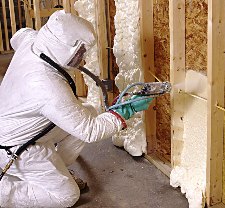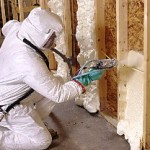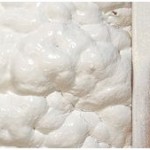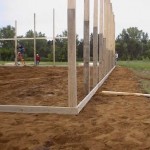I enjoy Hansen Pole Buildings’ Designers who really like to sink their teeth into a subject.
This morning Rick asks me, “Have you ever done a cost comparison on spray foam roof insulation vs the costs of condensation barrier, ceiling load trusses, joists, drywall ceiling and blown in insulation?”
The entire question was brought about, as Rick really gets his clients to think about how they will be using their buildings.
In order to do a comparison, I just plucked from the air a 40’x60’ building, double trusses every 12’ with a 4/12 roof slope and 12” overhangs. Fairly common, pretty standard.
So, what needs to be done in order to spray foam a pole building?
 For starters, keep in mind (by Code) spray foam insulation cannot be left exposed, it has to be covered with inflammable material – like gypsum wallboard. Gypsum Wallboard is not as flexible as steel, so it has deflection criteria which mean upsizing the roof purlins from 2×6 to 2×8, or changing the column spacing to 10’ on center(o.c.). In the end, when I priced it out the change to 10’ o.c. was less costly, adding only about $900.
For starters, keep in mind (by Code) spray foam insulation cannot be left exposed, it has to be covered with inflammable material – like gypsum wallboard. Gypsum Wallboard is not as flexible as steel, so it has deflection criteria which mean upsizing the roof purlins from 2×6 to 2×8, or changing the column spacing to 10’ on center(o.c.). In the end, when I priced it out the change to 10’ o.c. was less costly, adding only about $900.
In either case, the truss loading will need to be increased to support the extra weight of the system – the top chord loading for spray foam or the bottom chord to create the dead attic space. Statistically – pretty much a wash in costs.
Due to the run of the roof, the spray version is going to take a little more drywall – call it $50
In the northern ½ of the United States, the recommended minimum attic insulation is R-49.
Spray foam is not inexpensive. With 2×6 purlins on edge, the maximum foam insulation thickness is 5-1/2 inches. At R-7 per inch for closed cell foam, will result in an R 38.5. The going rate for spray foam runs from $1 to $1.25 per square foot (sft), per inch of thickness – plus travel and fuel surcharges. To keep it easy, I will use $1 and ignore the rest. Including the run of the roof, roughly 2520 sft at $5.50 per sft is going to cost $13,860.
Total added costs for spray foam = $14,810
How about fiberglass in a dead attic space?
Increased truss load has previously been covered.
Ceiling framing must be added between trusses to support the wallboard – roughly $1200 including all of the Simpson hangers.
A reflective radiant barrier must be placed between the roof purlins and the roof steel, to prevent condensation, which would then rain on the insulation. $650
And the ridge must be vented. Under $200
According to Lowe’s, to get an R49 with fiberglass would require 74 bags of blow-in insulation at $32.75 a bag for just over $2400.
Total costs for fiberglass = $4450.
In summary, spray foam costs would be roughly 333% of the cost of fiberglass, to get to 78% of the R value. The other downside is with spray foam, the area of the trusses now has to be heated (almost 8000 cubic feet of space) before the area below it is going to feel warm!









